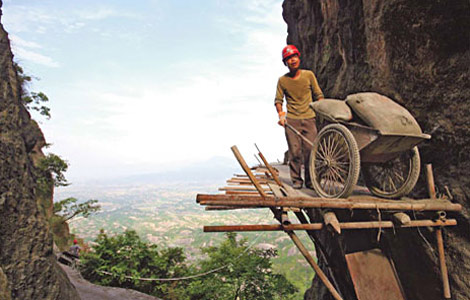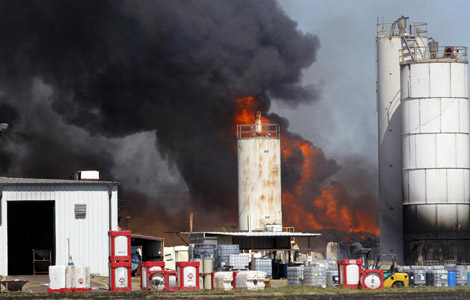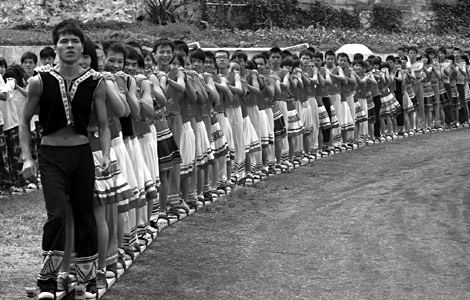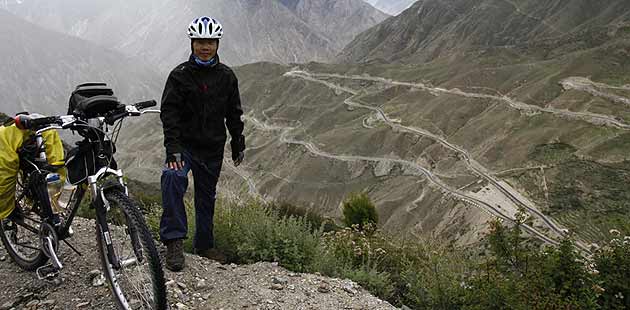Myitsone Hydropower Project mutually beneficial
Updated: 2011-10-04 08:02
(Xinhua)
|
|||||||||||
Q: Some reports pointed out that the project will only bring economic benefits for China. What's your comment on that?
A: This viewpoint is extremely wrong. People who hold such a wrong viewpoint either don't understand the situation or have ulterior motives. Regarding infrastructure, it is an international practice to implement BOT mode. According to our BOT agreement, upon completion of the upstream-Ayeyawady hydropower project, CPI will be responsible for operation for 50 years, after 50 years the project will be transferred to the Myanmar government free of charge.
Either in terms of direct economic benefit or indirect profit, the upstream-Ayeyawady hydropower project will significantly boost the fast development of economy and society in Myanmar. In terms of direct economic benefit, when the several hydropower stations in upstream-Ayeyawady basin, including Myitsone Hydropower Station, are completed, Myanmar government will gain economic benefits of USD54 billion via taxation, free electricity and share dividends, far more than CPI's return on investment during our operation period. In particular, as the design life of the project is over 100 years, when we transfer it after 50-year operation, the Myanmar government will have a fixed assets increase worth tens of billions US dollars, in addition to hundreds of billions US dollars of direct economic benefits. Of course, the premise is that US dollar is not depreciated.
In terms of indirect profits, first of all, the construction and operation of high-grade and large-capacity power station will rapidly improve the power equipment in Myanmar and cultivate a large group of professionals in power construction, operation and management. As a result, Myanmar's electric industry will realize leapfrog development, providing strong power ensurance for its economic and social development. Second, when Myitsone Hydropower Station is completed, it will effectively control and reduce the flood peak, raise the anti-flooding standard in downstream area, and reduce life and property losses caused by downstream flood on people living on both banks. The anti-flood capability of Myitkina will be enhanced from once in 5 years to once in 20 years. Third, 750km road and a large number of hydrological, meteorological and seismic observation stations will be built for upstream-Ayeyawady project accordingly. Those infrastructures will definitely create opportunities for the local area to attract business and capital and improve people's livelihood. Fourth, during the construction peak, more than 40,000 workers will be needed, considerably increasing local job opportunities. At present, there are altogether 2000 Myanmar workers on the construction site of upstream-Ayeyawady project, including 1400 Myanmar workers on the Myitsone Hydropower Project site. By directly participating in the construction of upstream-Ayeyawady project or providing relevant services for construction personnel, local residents have considerably improved their own economic and living conditions.
Q: Some people worry that construction of the dam will lead to such major hazards as flood and earthquake. Is there sufficient guarantee for dam safety?
A: As far as I know, in the more than 100-year history of hydropower development, no flood or destructive earthquake has ever been caused by dam construction. CPI is a responsible super-large energy enterprise with 18GW operating hydropower capacity in China. We are able to ensure the safety of dam construction. During the design and construction of Myitsone Hydropower Station, we involved topnotch experts and teams in China, who have designed more than 200 hydropower stations, including Shuibuya Hydropower Station with the world's highest concrete face rockfill dam and Malaysia's Bakun Hydropower Station. Repeated proving of the seismic safety evaluation of Myitsone proved the absolute safety and reliability of the project engineering scheme. The Myanmar government also organized famous consulting organizations and experts from Switzerland and Japan to prove that over and over. Both parties agreed that there was no seismic safety issue for Myitsone Hydropower Station.
The seismic design of the dam in Myitsone Hydropower Station follows the standard of fortification intensity 9, which is higher than fortification intensity 7 of Zipingbu Hydropower Station that has withstood the Wenchuan earthquake in Sichuan. To further fortify the overall seismic performance of the dam, we applied reinforced concrete grating to the top of downstream dam slope and implemented other seismic fortifying measures. In case of emergency, the surface and middle discharge orifices on the spillway can be used to rapidly lower the reservoir water level and ensure dam and downstream safety. We will build 25 digital remote control seismic monitoring stations in the reservoir area and arrange more than 700 safety monitoring instruments all over the dam in accordance with the safety monitoring standard applied to the world's highest concrete face rockfill dam so as to keep a close eye on the dam's working conditions during operation.
The anti-flood standard of the Myitsone dam is designed as once in 1000 years and ratified with once in 10000 years to ensure safe operation.
Q: Environmental protection has been a hot topic in hydropower development. Few western NGOs criticized that the project would seriously damage the environment. How do you respond on this?
A: I would like to ask: Did these organizations ever help Myanmar to develop economy when the Myanmar people were in most difficult situation? But now, with the slogan of 'protecting the benefits of the Myanmar people', these organizations are disturbing the Myanmar government to carry out economic project development to improve people's livelihood. I don't know what their real purposes are?!
Any human activity would cause some impacts on the environment, including power generating activities. Hydropower, thermal power, nuclear power, wind power and solar power generation would all impact the environment somehow. Striving to reduce the negative impacts caused by human activities on the environment is necessary for sustainable development. During the 100 years that the mankind develop hydropower, their awareness of environmental protection has been deepening, and their ability in that has also continuously improved with technological progress. It has become a common consensus that hydropower is the only renewable energy suitable for large-scale development now.
The Hoover Hydropower Station in America has been operating for 80 years now. It not only turns 700,000-hectare desert in western America into fertile farmland by providing reliable water source, but also creates the new city of Las Vegas. The Itaipu hydropower station jointly developed by Brazil and Paraguay has also played a significant role in the economic and social development of both countries. CPI's successful development of cascade hydropower stations in upstream Yellow River has not only provided a great deal of economic and reliable clean energies, but also ensured non-stop flow in the middle and lower reaches of Yellow River for the past 10 years. All these projects have impacted local environment in varying degrees, but their positive effects on local economic and social development is self-evident and indisputable.
CPI attaches great importance to environmental issues during project development, and started environmental impact assessment at the very beginning of project planning.
Regarding vegetation, we entrusted over 100 experts from China and Myanmar to conduct environmental impact assessment of the basin, some of them from Myanmar NGOs. According to site investigations, native vegetation only accounts for a small part in the flooded area, and the flooded land only accounts for 1.4 percent of the whole basin area. Besides, protected plants that are flooded are widely distributed outside of the reservoir area, so bio-diversity will not be impacted.
Regarding intrusion of seawater, after the reservoir begins storing water, average flow will be reduced by 3.5 percent in flood season and increased by 16 percent in dry season. Therefore, there is no possibility of seawater intrusion during flood season. Meanwhile, it can also help prevent seawater intrusion during the dry season. It is also good for navigation, flood control and irrigation in the downstream.
Q: Resettlement is also a hot topic in hydropower development. Resettlement work relates directly to the subsequent living quality of the migrants. What have you done in that regard?
A: The Myanmar government attaches significant importance to resettlement for the upstream-Ayeyawady hydropower project, and has effectively led and organized the planning, design and implementation of resettlement. They solicited migrants' opinions for several times regarding type of houses and subsidies for relocation, and eventually selected 2 resettlement locations with convenient traffic, good environment and favorable terrain for migrants from the Myitsone dam area. According to the agreement, we assisted in the resettlement work and proactively fulfilled our social responsibilities and obligations, while fully respecting local religion, ethnic customs and the wish of migrants.
The basin that upstream-Ayeyawady project is located features a typical terrain of high mountains and river valley. When the power stations are completed, flooded area only accounts for 1.4 percent of the whole basin area, and less than 20000 people have to be relocated because of the cascade hydropower stations in the basin.
There are 5 villages in the dam area of Myitsone Hydropower Station, totaling 2146 people of 410 households. The houses we provided for migrants are 2-storey wood-and-brick structure, and we provided each household with 100,000-Kyat living subsidy, a 21-inch color TV and other living necessities. We also reasonably subsidized migrants for their private orchids and economic forests. Compensations for the dam area amounted to billions of Myanmar Kyat and were all distributed into migrants' hands. In order to ensure the subsequent lives of migrants, we newly reclaimed 440 acres of land, and distributed money to every household for land leveling related expenses, rice for a year, 30 kilo rice seeds and 50 kilo fertilizers. At the same time, all infrastructures such as schools and hospitals are concrete structure, and all students are provided with textbooks, uniforms and stationery. Auxiliary facilities including high-standard religious venues, police stations, firefighting and administration buildings, post offices and markets are set up, 20km concrete road is built, and steady water and electricity is supplied for communities. Resettlement has been completed now, and living standard of the migrants has been greatly improved compared with before, so they are satisfied with their current living conditions.
We will fully draw on our experience in resettlement of dam area for the resettlement in Myitsone reservoir area to make it more rational and feasible. Flooded roads and bridges in the reservoir area will be rebuilt on the principle of "equal or superior to former standard" so as to meet the traffic requirements of local residents.
We also attach great importance to long-term assistance to the migrants. We have set about planning and building animal breeding and vegetable growing bases in the basin, hire local people to provide logistic services for project construction, with the aim to create more and better jobs and ensure the sustainable development of migrants.
There are two old sayings in China. One is "seeing is believing" and the other "he is wise who is open to all opinions, but a fool who only believes what he wants". I believe all of you will come to a just and objective conclusion with awareness of the real situation.
Hot Topics
Libya conflict, Gaddafi, Oil spill, Palace Museum scandal, Inflation, Japan's new PM, Trapped miners, Mooncake tax, Weekly photos, Hurricane Irene
Editor's Picks

|

|

|

|

|

|







